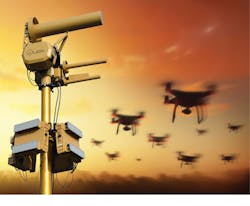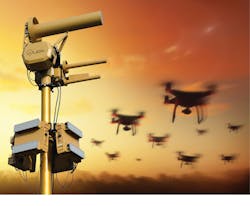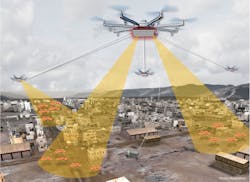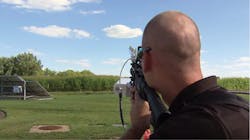The fight against unmanned aircraft intrusions
Counter-drone efforts include RF energy handheld devices, nets, birds of prey, laser weapons, and even surface-to-air weapons to detect, track, and neutralize unmanned aircraft threatening military forces, prisons, and critical infrastructure.
By J.R. Wilson
One of the best examples of how rapidly advancing technologies can change security requirements is the rise of unmanned aerial vehicles (UAVs). Relatively unknown to all but a few in the military as recently as 1990, today they are central to militaries throughout the world; the general public can even buy them in grocery stores.
NOTE: The U.S. government has adopted the generic term UAS-unmanned aircraft system-which includes launch systems and ground control stations. This article deals only with the unmanned aircraft, weapons, software, and sensor payloads, so we are using UAV except in direct quotes.
The U.S. Federal Aviation Administration (FAA) and its counterparts around the globe have been struggling to define operational limitations on UAV flight parameters, especially around airports, where several apparently accidental incursions already have threatened safe commercial aircraft takeoffs and landings.
The U.S. Secret Service, Department of Homeland Security (DHS), FBI, and military also are installing state-of-the-art sensors and quick-reaction defenses around the White House, U.S. Capitol, Supreme Court, and other federal facilities - domestic and overseas. The same applies to port perimeters, major rail heads, critical infrastructure, government buildings, and military bases.
"The FAA works closely with our law enforcement community partners to respond to and investigate UAS incidents and accidents," FAA officials say. "When the operator can be identified, the FAA and the appropriate law enforcement agency work together to investigate the event to determine if any administrative or criminal violations have occurred. FAA works closely with our federal law enforcement, security, and defense partners to share information regarding the risks of possible malicious uses of UAS and consults with them regularly on opportunities to address those risks through regulatory actions and other mitigation measures.
"UAS are a comparatively new, but fast-evolving, technology with operators who are not familiar with aviation or operating aircraft in the National Airspace System [NAS]," FAA officials continue. "In fact, many UAS operators do not recognize they are now part of the aviation system, which leads to a lack of awareness and understanding of their responsibilities for safe operation and the potential risks they can pose by operating unsafely in the airspace."
The Aerial Dragnet from the U.S. Defense Advanced Research Projects Agency seeks to detect several small UAVs in complex and urban terrain before they are within line of sight of U.S. and allied assets.
Originally used by the military for intelligence, surveillance, and reconnaissance (ISR) flights over adversaries overseas, the first weaponized UAV - a CIA-owned General Atomics Predator - took to the air over Afghanistan in October 2001 in support of the post-9/11 U.S. invasion.
In the 16 years since, millions of UAVs, ranging from small, hand-launched ISR platforms to civilian quadcopters to the massive long-range/long-duration Northrop Grumman Global Hawk, have been produced by hundreds of companies and sold to virtually every nation on Earth.
The number of commercial UAVs also has exploded since regulations were relaxed in 2016, when there were 42,000 operating in the U.S. The FAA predicts those platforms - used for everything from agriculture to news gathering - will increase by more than 10-fold by 2021. The speed and size of growth in civilian sectors will depend heavily on future FAA regulatory changes, which have only been a factor for about a decade.
In May 2006, the FAA issued its first certificate of authorization on UAVs, allowing General Atomics M/RQ-1 Predators and M/RQ-9 Reapers to fly in the NAS on disaster search-and-rescue missions. That action came, in part, as a response to Hurricane Katrina the previous year, when requests to use UAVs for SAR were denied due to a lack of FAA authorization. One Predator sensor that helps make it a formidable weapon of war - an infrared camera, with digitally enhanced zoom, able to identify the heat signature of a human body from an altitude of 10,000 feet - also makes it an ideal SAR tool.
The FAA made registration of small hobbyist UAVs mandatory in 2016; as of March 2017, nearly 800,000 civilian UAVs had been registered - far less than the estimated 1.1 million that had been sold in the U.S. alone by that time. The FAA predicts consumer-owned UAVs in the U.S. will reach 3.55 million by 2021, an annual growth rate of more than 26 percent, but other estimates put that number at 4.55 million.
Counter-UAV programs
The FAA, DHS, FBI, Coast Guard, and local law enforcement are under great pressure to develop better, faster ways to detect even small UAVs. Detection is only the first step, however. Protecting potential targets by stopping the aircraft before they do any harm, whether deliberate or not, is the objective of a wide range of Counter-UAV (C-UAV or C-UAS) programs.
"UAS technology is dynamic - and the systems and technologies that address the potential unsafe or malicious use of UAS will also have to be dynamic," FAA officials say. "Such efforts will likely involve a mix of technologies and regulations associated with requirements that focus on the UAS, the operator and the airspace in which they operate. The interagency approach has led to DHS developing a shared knowledge database helpful in the development of civil detection and mitigation requirements while meeting federal statute and privacy requirements.
"The FAA is committed to working cooperatively with DHS and other government partners to support C-UAS R&D in a manner that is consistent with aviation safety and does not negatively affect the FAA's provision of safe air navigation services," FAA officials continue. "The FAA is also committed to working a whole-of-government approach for addressing legal authorities related to the federal government's ability to utilize some technologies to mitigate UAS threats. Future FAA activities include identification and tracking and other regulatory measures that will go a long way in eliminating a high percentage of errant or unknown UAS operations."
What it does not include, an agency spokesman adds, are any plans for the FAA to use UAVs of its own in a C-UAV capacity.
The evolution of UAVs in the past 25 years can be compared to that of cell phones in the same time. Both have gone from expensive curiosities of only marginal utility to ubiquitous, highly reliable devices with increasingly advanced capabilities. And part of the potential for both good and ill is the ability to merge small commercial UAVs with high-tech smartphones.
"When you talk about technology advancement, you can to see the differences in UAV sizes and abilities just in the commercial world. And industry has responded to that. So as quickly as GoPros and cell phone cameras have advanced, those have migrated into the technology," says Harvey Lai, C-UAV lead at the Army's CERDEC Intelligence & Information Warfare Directorate (I2WD).
This is a growing concern for the military, and, by extension, for anyone else concerned about privacy or security, adds Kevin O'Hanlon, senior engineer in I2WD's Radar Division.
UAV proliferation
"As you start addressing the current threat, it becomes more advanced and capable and you have to address it again. The consumer wants to do more with UAVs, which is a huge driver to put more capability into those you can buy off-the-shelf," O'Hanlon says. "UAVs have proliferated in the past couple of years, largely due to consumer demand. And anyone paying attention can easily see the possibilities of their use as things get cheaper and consumers demand more out of them.
"The Army has to worry about more than just 'is it happening,' but the future potential for any adversary trying to affect us; we have to be ready for whatever potential there may be," O'Hanlon says. "That is our function in the Army, as one of its research and development centers [RDECs], to look at the community and develop long-term strategies for the five- or ten-year path, what's the art of the possible. But it is an ever-changing world, so we do constant updates. It's not an exact science, but something you have to put on paper, start working toward and adjust as needed."
Also looking at both current needs and, to an even greater extent, what may be 10, 20, or even 30 years from now, is the Defense Advanced Research Projects Agency (DARPA), which was created after the Soviet Union launched Sputnik, the world's first satellite, and with it claimed the global lead in both space and technology. DARPA's mission, set out by President Dwight Eisenhower, was not only to ensure the U.S. never again was the victim of technological surprise, but to be the source of all future technology surprises.
Two ongoing DARPA projects aimed at developing next-generation C-UAV capabilities are the Tactical Technology Office's (TTO's) Mobile Force Protection (MFP) and Aerial Dragnet in the agency's Strategic Technology Office (STO). DARPA outlined the status of and future plans for both in its RDT&E (Research, Development, Testing & Evaluation) Project Justification submission for the U.S. Department of Defense (DOD) 2018 budget estimates.
The Battelle DroneDefender system uses RF energy to commandeer encroaching UAVs and lower them safely to the ground. Problems with the U.S. Federal Communications Commission (FCC) has limited its use and deployment.
"The goal of the MFP program is to develop and demonstrate an integrated system capable of defeating a raid of self-guided, small unmanned aircraft attacking a high-value convoy on the move. By focusing on protecting mobile assets, the program will emphasize low footprint solutions, in terms of size, weight, and power (SWaP), and manning, which will benefit other counter-UAS missions and result in more affordable systems," the document explains.
The DARPA Mobile Force Protection (MFP) program seeks to develop an integrated system able to defeat a raid of self-guided small unmanned aircraft attacking a high-value convoy on the move.
"Defending in a variety of operating environments against these sUAS [small UAS] threats and associated concept of operations requires several breakthroughs in affordable technology to 'sense, decide and act' on a compressed timeline while mitigating collateral damage. The program seeks to develop solutions applicable to the defense of mobile ground and naval forces that can also potentially defeat more conventional threats. The solution will be scalable and modular such that it can be deployed in multiple defense applications and does not become obsolete with evolving threat capability," the document continues.
Military-civilian crossover
The crossover potential of military C-UAV technologies to civilian applications also is central to MFP, which DARPA is working on not only with all the military services, but also with the DHS Science & Technology Directorate and the U.S. Coast Guard. As part of that, as each open-air demonstration ends, DARPA will offer all interested parties the opportunity to fund extended field evaluations. The agency's stated goal "is to develop the interim versions and the final prototype system to meet the needs of a broad number of potential U.S. government and commercial users."
DARPA recently awarded phase-one agreements to expedite the development of C-sUAV capabilities and get them into the field quickly to three teams, led by Dynetics Inc. in Huntsville, Ala.; Saab Defense and Security USA in East Syracuse, N.Y.; and SRC Inc. in North Syracuse N.Y.
"The three teams we've assembled have innovative ideas for a versatile, layered defense system that could protect convoys on the move from multiple small unmanned aircraft systems in real time," says Jean-Charles Ledé, the DARPA TTO acting deputy director. "Each team will now work to integrate novel ideas for advanced sensors and neutralization approaches into a common framework, emphasizing safety for civilian bystanders, ease of operation and low size, weight, power, and cost [SWaP-C]. Our goal is a technology demonstration system that could fit onto currently deployed tactical ground vehicles and maritime vessels - getting advanced and upgradeable capabilities quickly to the warfighters who need them."
With respect to Aerial Dragnet, 2018 plans include completing development of initial hardware sensor payloads, evaluating software for non-line-of-sight (NLOS) UAS tracking and classification, and demonstrating and testing system performance over a neighborhood-sized urban area.
The U.S. Navy AN/SEQ-3 Laser Weapon System (LaWS) can destroy enemy unmanned aircraft, as well as other airborne threats. It was installed on USS Ponce for field testing in 2014.
"Aerial Dragnet seeks to detect multiple sUAS in complex and urban terrain before they are within LOS of friendly assets," DARPA officials say. "Unlike traditional air targets, sUAS pose a special threat in urban terrain for several reasons: they can fly at low altitudes between buildings; they are small, making them difficult to sense, and they move at slow speeds, making them difficult to differentiate from other movers. Moreover, the development of sUAS is driven by commercial technologies, which make them rapidly adaptable and very easy to use."
Networked sensors
"Building upon technologies developed in the System of Systems Integration Technology and Experimentation (SoSite) program, Aerial Dragnet will perform surveillance using an architecture consisting of networked sensors mounted on distributed aerial platforms," DARPA officials continue. "The ability to see over and into urban terrain allows an Aerial Dragnet to rapidly detect, track and classify UAS incursions, thus enabling multiple defeat options. This program focuses on the development of payloads, to be hosted on unmanned aerial platforms, comprising signal processing software, sensor hardware, and networking for distributed, autonomous operation."
Scalable to provide cost-effective surveillance from neighborhood to city-sized areas, Aerial Dragnet technologies are expected to move to the Army and U.S. Marine Corps for missions in Europe and Southwest Asia. In addition, with its focus on mounting the system on existing UAVs, it could move quickly to law-enforcement agencies and the U.S. Border Patrol, which is evaluating sUAVs in operational areas.
"We anticipate the sUAS program to be a valuable tool for Border Patrol's highly trained law enforcement personnel in securing our borders and helping identify and intercept illicit activity along U.S. borders," says Carla Provost, acting chief of the U.S. Border Patrol. "These aircraft will enable Border Patrol agents to surveil remote areas not easily accessible by other means, which is critical to our ability to secure the border. They will also be invaluable for humanitarian missions, aiding in locating individuals in need of medical assistance along inhospitable areas of the border."
These aircraft also would be assets in detecting and helping negate UAVs employed by drug cartels and other criminal - and possibly terrorist - organizations along the nation's borders.
Two fixed-wing aircraft and one helicopter are being tested operationally - AeroVironment's RQ-20 Puma and RQ-11 Raven and Tactical Robotics' InstantEye Quadcopter - all small enough to fit inside a sport utility vehicle (SUV) and be maneuverable and rapidly deployable.
The first of two testing rotations in three Border Patrol sectors - Tucson, Ariz.; Rio Grande Valley, Texas; and Swanton, Vt. - began in September 2017, with the second to begin in January 2018.
After measuring hot- and cold-weather capabilities, Border patrol officials say they expect a final review, including future investment decisions and expansion of the program to other BP Sectors, in late spring 2018. The evaluations are being conducted under an approved Memorandum of Agreement between the FAA and BP that "maximizes risk-avoidance to commercial and general aviation traffic in the National Airspace System."
A second MOA with CBP's Air and Marine Operations is intended to further address "operational risk avoidance in day-to-day operations."
FAA efforts
Over the past two years, the FAA's congressionally mandated UAS Detection Pilot Program conducted a series of evaluations on UAV detection systems at Atlantic City International Airport, JFK International Airport in New York, Denver International Airport, and Dallas-Fort Worth International Airport. The evaluations employed temporary and limited installation of various detection systems under Cooperative Research Development Agreements with several system manufacturers, testing the ability of their sensors and systems to detect approaching UAVs using radar, radio frequency, and electro-optical technologies.
"The effort, in collaboration with industry and federal partners, provided stakeholders with credible, objective and useful information about the performance and capabilities of UAS detection technology, its state of development, and potential areas of risk," says one FAA program official. "This pilot program has concluded and the team is compiling a report based on the technology evaluations conducted."
The U.S. Army and Marine Corps can rely on the AN/TWQ-1 surface-to-air missile system, which protects ground units from UAVs, as well as cruise missiles, low-flying fixed-wing aircraft, and helicopters.
Meanwhile, DHS, partnered with other federal agencies, is working on common test methodologies and data definitions for C-UAV. As part of that, the FAA's UAS Center of Excellence (CoE) is analyzing data provided by the manufacturers from the airport evaluations. Their results are expected in 2018.
International efforts
Because the threat is international and cuts across all segments of society, the FAA and some of its partners have taken their tests to other nations. For example, they recently observed testing of a prototype C-UAV system at Finland's Helsinki International Airport and technology demonstrations at overseas and domestic DOD bases.
The SkyWall counter-drone system from OpenWorks Engineering Ltd. in Stocksfield, England, enables operators to capture any suspicious drone and bring it to the ground safely, without raising alarm or causing collateral damage.
"The FAA has reviewed C-UAS technology testing and assessment findings from DHS, the Department of Energy, DOD, the U.S. Army and Air Force, the Federal Bureau of Prisons, and the FBI," an agency official says. "The FAA also participates in an ongoing whole-of-government effort focusing on issues associated with countering risks posed by UAS, including legal issues, technology developments and domestic use of such technologies.
"To support evaluations, the FAA has employed the services and expertise of the FAA Modernization and Reform Act 2012-mandated UAS Tests Sites, as well as the FAA's UAS CoE. The FAA also has engaged with DHS, DOD, and two Federally Funded Research and Development Corporations to assess the potential cost of deploying such UAS detection technologies at a large metropolitan airport," the FAA official says.
The FAA says its assessments and observations of current UAV detection technologies are limited by the developmental state of most systems being evaluated for civil applications in the United States.
"Until such time as standards are developed and published and more formal test and evaluation is conducted, addressing technological improvements will remain difficult. Future solutions will likely comprise multiple sensor systems to provide the most accurate and timely detection and response and will need to evolve to keep pace with UAS technology changes," an agency official says.
"The FAA and its interagency partners will continue to shape potential requirements for UAS detection technology that will assist in keeping the NAS the safest system in the world. Based on the assessments conducted, the FAA has concluded there is no one, simple solution for UAS detection. Future FAA activities, including identification and tracking and other regulatory measures, will be critical to eliminating a high percentage of errant or unknown UAS operations."
No silver bullet
C-UAV development, both military and civilian, continues to pick up speed and urgency, but tests to date have shown there is no "silver bullet" capable of addressing all types of UAVs and their potential payloads, from ISR sensors to eavesdropping smartphones to explosives. Nor is any one lab or agency able to push C-UAV R&D forward with the necessary speed and SWaP-C requirements. CERDEC, for example, is pursuing cooperative investigations into C-UAV detection and mitigation technologies with multiple government agencies, industry and the armed services.
"Research labs in academia are really going after the far-out problem, while most government labs are dealing with the mid-term problem," O'Hanlon says. "There also are working groups stood up to work with our allies, who have different experiences than our own services, so that helps us get to a cooperative solution. It is a system-of-systems approach. Commercial RCMAs [radio-controlled model aircraft] are a challenge to detect, identify, track, and negate. There are shortfalls with every type of sensor, so working as a networked SoS, performance is helped."
CERDEC's Lai says the military's RDECs, in their mid-term solutions search, are "squeezing every bit of capability out of each sensor technology, as they exist today. We are looking at every possibility, working with industry to present quick-reaction capability that is mission-specific, to long-term SoSs, improving sensor technology to address both the here and now and later."
CERDEC officials admit they don't have the answers yet and, given the speed of technology development and breakthroughs, it is unlikely the C-UAV issue will ever be fully resolved before it morphs into an as-yet unknown new threat.
"Part of the work we're doing now is to help work out some of those problems and inform the Big Army on the best or potential solutions so they can decide how to move forward. In general, work with the art of the possible," O'Hanlon adds. "Determining the art of the possible involves confidence in information. Near-term, it's easier to provide a higher confidence look at the threat and what we can do. The further out you go, the more difficult that comes, so you have to make adjustments."







